Genre: Shmup Developer: Wolf Team Publisher: Renovation Players: 1 Released: 1992
For a while, it was hard to not notice Renovation if you were a Genesis owner. Seemed like every couple of months, it was putting out a new game in the U.S. While it covered a fairly broad range of genres in its time with the Genesis, one of its more populated areas was the field of shmups. However, an interesting thing happened with one of the shmups it published. In Japan, a shmup made by Wolf Team called Sol-Feace was released for the Sharp X68000 in 1990, then got ported to the Mega CD and filled with CD-quality music in 1991. Later, when the Sega CD got its U.S. launch in late 1992, Sol-Feace had been translated and used as a temporary pack-in for the add-on. However, sometime in the first few months of 1992, the game was released in cartridge form for the U.S. and slightly renamed to Sol-Deace. An odd choice to be sure, likely done to either give the game a wider audience, or Sega hadn’t asked for permission to bring the CD version over yet. So, was this CD-to-cart port worth it, or was it just a waste of plastic and silicon? Read on.
In 3,000 AD, mankind is in a battle for its survival. A super computer called the GCS-WT has enslaved humanity… a cruel twist of fate, given that it was humans who built it. In an attempt to regain control of their lives, humans try to fight the super computer, but lose miserably to the mechanical hordes that the GCS-WT unleashes as it fights back. The end result, is humans having to hide from the GCS-WT’s systematic elimination of their kind. But all is not lost, for the efforts of one late Dr. Edwin Deace is en route to Earth. Built from Dr. Deace’s research into inorganic matter before he was killed by the forces of the GCS-WT, Sol-Deace is a highly advanced and powerful ship… one on which all the fading hopes of mankind rest as you, Eric and Misao race through the darkness of space to destroy the GCS-WT in a clash of oil and blood.
Graphically, Sol-Deace is not too bad-looking. There isn’t a lot of depth to the graphics when it comes to parallax scrolling, but this game comes off well in other areas. The ship designs, while a touch generic on some of them, have plenty of shading to give them form, and feature nice details. The enemy ships range from tiny to good sized, with a healthy portion of them being animated in one form or fashion. The bosses are often large with various arms, tongues and such waving around them as they move, which brings up one of the more surprising visual aspects to this game. That being, the smoothness of motion the bosses tend to have. Using multi-jointed segments and rotated sprite sets where needed, the arms/guns/bodies and such were given a greater sense of fluidity. It can look a bit odd at times, but it’s a nice touch that makes the bosses feel more like mobile killing machines rather than robotic clunkers… a trait added to with how quickly some of the bosses animate.
The backgrounds are kind of scattered in terms of quality, but they basically range from average to good. As mentioned, there isn’t a lot of parallax going on, with most of them having just two layers (one on occasion), but at least they’re not all simply star fields. Asteroid bases, a star’s surface, a moon of Jupiter… those are some of the kinds of locales you’ll be flying through. They won’t floor you with their originality, but they do feature a fair bit of detail, plenty of obstacles to avoid and be crushed by, as well as some tight squeezes. There’s even the prerequisite multi-screen battleship to fly around and destroy bits of. So while the visuals have a bit of “been there, done that,” the game as a whole comes off looking good.
With sound, Sol-Deace fairs well. The music is often catchy, at times dramatic, and fits with what’s going on much of the time. It has the familiar Motoi Sakuraba sound that’s heard in other games he’s scored (Arcus Odyssey, Earnest Evans, El Viento, etc.), with instrument samples that are good quality with nice synths and drums, but occasionally tinged with an iffy synth here and there (like the initial hit of the buzz/mosquito-like synth used about fifteen seconds into stage one’s song). The sound effects are plentiful, and like the music, are going to be familiar to some (they too were used in a number of games by Wolf Team). But unlike the music, they’re not quite as nice. There are plenty of them, which is great, but a fair number of them are basically just variations of the same general sound. Even so, the overall package comes off pretty nicely in the aural department, even if the music seems to have been given more love.
The gameplay of Sol-Deace is standard shmup fare for the most part. You can speed up and slow down your ship (before you start playing mind you), gain various power-ups, and you have to dodge a lot of bullets/objects. You’ll play through seven stages, taking you from Pluto to Jupiter and even to an artificial sun as you make your way to Earth. Each stage culminates in a boss encounter, with bosses that resort to not just firing at you with tracking, random and pattern-based bullet spreads, but at times moving on-screen and having appendages that they swing around.
To fight all of this, you’ll have three weapons at your disposal: a twin shot, a grenade-like shell, and a long-beamed laser. The twin shot’s the weakest, but it fires fast and makes for good coverage of the screen. The grenades pack a punch and curve outward but don’t fire as quickly, and the laser can be handy with how it fires, but it does so even more slowly than the grenade shot. There is a fourth weapon; however, it’s really only temporary… your thrust booster. In stages four and five, a big flame can be seen coming out of the back of your ship, and this flame hurts enemies. It won’t help you too much with the big battleship (stage four), but it does come in handy for the ships behind you on stage five.
To help break out of the “me too” mold a little, this game does offer up a few things that are a bit different from the norm. The first, is that rather than touching a scrolling landmass to die right there, your ship bounces off of it. A bullet and ramming an enemy/piece of space debris still kills you on the spot, but if you nudge part of the ceiling or floor, you’ll get bounced away at a roughly 45º angle forward. This is both handy (no insta-death) and dangerous, as it can bounce you into an enemy or bullet, so it’s a curse and a blessing in ways.
The second way this game branches out a bit is with how the power-ups are used. Instead of C.R.A.W.s, sidekick ships or options, you get an upper and lower weapon arm attached to your ship, and the power-ups get attached to those arms based on which side you pick up the power-up. If you hold down the fire button, these arms stay in place. However, if you stop firing, the arms can be adjusted by moving your ship. As an example, moving forward will open the arms, moving back will close them. This can lead to some handy strategies as you blast your way through the various levels and bosses. You can also pick up a weapon on the nose of your ship, so that’s at your disposal as well. And if you don’t like a weapon or where you put it, just pick up a different type by touching the power-up with the part of your ship you want it attached to (sadly, no cycling what you already have).
And now we ask, “what’s wrong with the game?” Well, the controls, hit detection and challenge level are all good, giving the game a solid foundation to build the visuals and audio on, so it’s not those areas. The biggest issue with Sol-Deace is the flicker. With large ships, bullets, explosions, and such going on everywhere, flicker is a regular occurrence as you play. For the most part, it just hides bits of the big enemies. But there are times when the flicker will hide a gun turret, a small enemy/object, your ship, and even cause bullets to blink out of existence for a short time. This can result in some pretty unfair deaths, and while it doesn’t necessarily break the game, its presence it basically on every stage.
On the more minor side, as I said earlier, Sol-Deace has a bit of a generic quality to it. Really, your ship’s weapon arms, and the bosses with their appendages flailing about as they fly, walk and jump, are the game’s biggest stand-out features (along with the animation level at times). But while none of the ship or enemy designs are ugly or bad looking, they feel like you’ve seen them before in a dozen other sci-fi games at times, and the stages are the same way. You’ve been around the battleship, a moon’s surface and all that. And while these things don’t drag the game down due to poor quality, they don’t elevate it via creativity either. Another small issue is that there’s a little slowdown in spots. It’s not nearly as prevalent as the flicker, but it does crop up when things get hectic. Finally, one last gripe is that the weapon selection is a little dry. Three weapons and no additional powering up for them is a bit disappointing. The weapons are diverse, but one can’t help but think that Wolf Team could have made one or two more to choose from since the weapons can’t have their power levels increased.
As a final note, I imagine a few want to know how the cart and CD differ. Obviously the music is different. The CD is redbook audio using high quality synths, where the cart uses the Genesis sound chip (though to good effect) for the same song compositions. The CD version sends you back to stage five if you continue on stage six or seven, while the cart doesn’t (at least on normal difficulty). And though the cart version’s missing the opening cinemas (the song from one of them is still there oddly enough), here’s an interesting tidbit about it. There’s a new opening prologue, the story’s been altered slightly (the cart mentions that humans made the GCS-WT, the CD simply says it’s a dominating computer life form), and the ending for the cart is better and longer. The CD’s ending is done and over with very quickly, even when you include the credits. But the cart offers you a more satisfying conclusion, and a pretty cool effect for the credits. Go figure, eh? And lastly, for whatever reason, the same upper difficulty on the cart is called “advanced,” while it’s labeled “mania” on the CD. Otherwise, the stages, bosses, animations, sound effects, bullet/enemy count, flicker amount… they’re all basically identical.
So in the end, what can be said about this middle child between releases of Sol-Feace? Well, despite that it’s an 8Mb cart, the entire game is essentially there. Wolf Team didn’t push the Sega CD too hard, so little really had to be removed outside of the actual game itself. The loss of the opening cinemas and CD audio is a shame, but the cart turned out better in a spot or two thanks to what I feel is a much better ending and no load time pauses. Yes, there’s a generic tinge to the game, the backgrounds look very flat in spots, and the flicker is annoying, but the overall game itself is a solid entry to the genre. Not bad, not great, but solid with some smooth animation qualities, nice visuals and sound, and an interesting weapon system. So while it’s no Thunder Force IV or Steel Empire and has some issues, it’s an enjoyable game that can be found pretty cheap if you like the genre.
SCORE: 7 out of 10

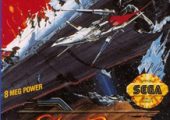
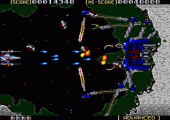
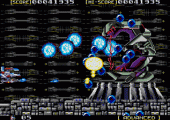
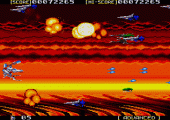
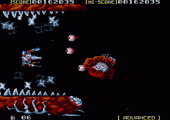
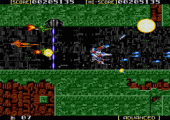
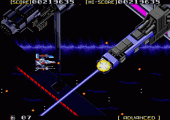
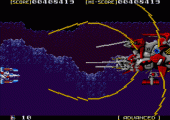
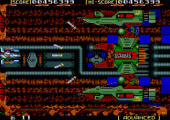
This is one of the more difficult horizontals I’ve played, since I usually get stuck at the battleship and those turrets are very difficult to destroy after a respawn and back to basic power.
Only ever played the mega drive version of this. I can see why it’s not considered a shmup masterpiece, but I’ve always had a bit of a soft spot for it.
Same here. As disappointed as I was with Sol-Feace when unboxing my Sega CD and seeing this fairly bland looking game being pushed as “the next level,” there’s something enjoyable about it that is tough to narrow down. This Genesis version is just as solid a game, and while it’ll never be among those shooters such as Thunder Force III and Gaiares which are typically highlighted as the system’s better games, Sol-Deace manages to be just as fun as many of the other big name releases.